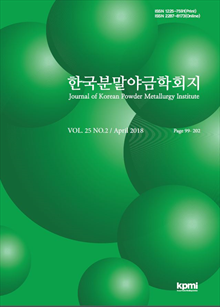간행물
한국분말야금학회지 KCI 등재 Journal of Korean Powder Metallurgy Institute

- 발행기관 한국분말재료학회(구 한국분말야금학회)
- 자료유형 학술지
- 간기 격월간
- ISSN 1225-7591 (Print)2287-8173 (Online)
- 수록기간 1994 ~ 2024
- 주제분류 공학 > 금속공학 공학 분류의 다른 간행물
- 십진분류KDC 559DDC 629
권호리스트/논문검색
Vol. 13 No. 4 (2006년 8월) 8건
1.
2006.08
구독 인증기관 무료, 개인회원 유료
4,000원
2.
2006.08
구독 인증기관 무료, 개인회원 유료
Yttrium aluminum garnet (YAG) powders were synthesized via mechanochemical solid reaction using with three types of aluminum compounds. reacted mechanochemically with all A1 compounds and formed YAM (yttrium aluminum monoclinic), YAG and YAP (yttrium aluminum perovskite) phases depending on the starting materials. The ground samples containing showed the best reactivity, whereas the ground sample containing A100H, which had the largest surface area, exhibited pure YAG after calcination at . The sample containing Al had the least reactivity, producing YAP along with YAG at . The types and grinding characteristics of the starting materials and grinding time are believed to be important factors in the mechanochemical synthesis of YAG.
4,000원
3.
2006.08
구독 인증기관 무료, 개인회원 유료
Wear behaviors of gas atomized and extruded Al-Si alloys were investigated using the dry sliding wear apparatus. The wear tests were conducted on Al-Si alloy discs against cast iron pins and vice versa at constant load of 10N with different sliding speed of 0.1, 0.3, 0.5m/s. In the case of Al-Si alloy discs slid against the cast iron pins, the wear rate slightly increased with increasing the sliding speed due to the abrasive wear occurred between Al-Si alloy discs and cast iron pins. Conversely, in the case of cast iron discs against Al-Si alloy pins, the wear rate decreased with increasing the sliding speed up to 0.3m/s. However, the wear rate increased with increasing the sliding speed from 0.3m/s to 0.5m/s. It could be due to adhesive wear behavior and abrasive wear behavior_between cast iron discs and Al-Si alloy pins.
4,000원
4.
2006.08
구독 인증기관 무료, 개인회원 유료
The amorphous alloy strip was pulverized to get a flake-shaped powder after annealing at for 90 min and subsequently ground to obtain finer flake-shaped powder by using a ball mill. The powder was mixed with polyimide-based binder of , and then the mixture was cold compacted to make a toroidal powder core. After crystallization treatment for 1 hour at , the powder was transformed from amorphous to nanocrystalline with the grain size of . Soft magnetic characteristics of the powder core was optimized at with the insulating binder of 3wt%. As a result, the powder core showed the outstanding magnetic properties in terms of core loss and permeability, which were originated from the optimization of the grain size and distribution of the insulating binder.
4,000원
5.
2006.08
구독 인증기관 무료, 개인회원 유료
In this study, the colloidal stability and sedimentation behavior of crystalline particles (300nm) in various organic solvents have been investigated by means of a backscattered light flux profile (Turbiscan). The backscattered light flux profiles revealed that the nanoparticles were readily sedimented in water, methyl alcohol, and ethyl alcohol due to a flocculation-induced particle growth, while a particle coalescence and a sedimentation of the nanoparticles were hardly observed in isopropyl alcohol. The migration velocities of the particle were measured as around 6.15/min, 12.53 m/min, 6.51m/min, and 0.18m/min for water, methyl alcohol, ethyl alcohol, and isopropyl alcohol, respectively, showing a remarkably slow migration of the particles in isopropyl alcohol
4,000원
6.
2006.08
구독 인증기관 무료, 개인회원 유료
[ ] oxide layer on the surface of each W(tungsten) nanopowder produced by the electric explosion of wire(EEW) process were formed during the 1vol.% air passivation process. The oxide layer hindered sintering densification of compacts during SPS process. The oxide phase was reduced to the pure W phase during SPS. The W nanopowder's compacts treated by the hydrogen reduction showed high sintered density of 94.5%. after SPS process at .
4,000원
7.
2006.08
구독 인증기관 무료, 개인회원 유료
Spherical Ag powder was prepared in the system of by wet chemical reduction method. The size of Ag powder was increased as the reaction temperature and the concentration of reducing agent was decreased in the constant concentration of dispersion agent. Optimum conditions of producing Ag powder having of D50 was 1M of , 0.5M of , 1.5g of Gelatine in the room temperature.
4,000원
8.
2006.08
구독 인증기관 무료, 개인회원 유료
Co-Fe-Ni-B-Si-Cr based amorphous strips containing nitrogen were manufactured via melt spinning, and then devitrified by crystallization treatment at the various annealing temperatures of for up to 30 minutes in an inert gas atmosphere. The microstructures were examined by using XRD and TEM and the magnetic properties were measured by using VSM and B-H meter. Among the alloys, the amorphous ribbons of containing 121 ppm of nitrogen showed relatively high saturation magnetization. The alloy ribbons crystallized at showed that the grain size of alloy containing 121 ppm of nitrogen was about f nm, which exhibited paramagnetic behavior. The formation of nano-grain structure was attributed to the finely dispersed Fe4N particles and the solid-solutionized nitrogen atoms in the matrix. Accordingly, it can be concluded that the nano-grain structure of 5nm in size could reduce the core loss within the normally applied magnetic field of 300A/m at 10kHz.
4,000원

